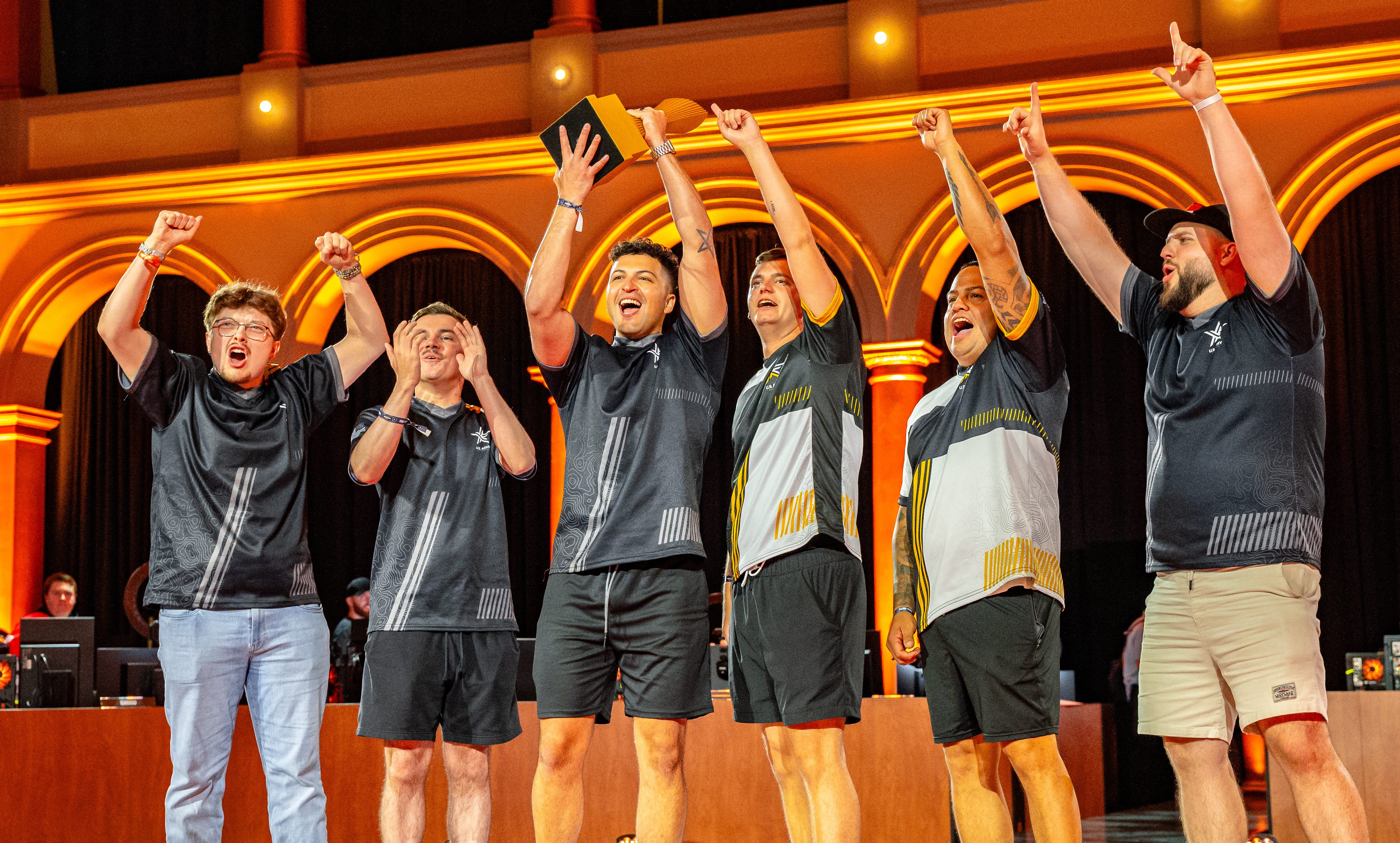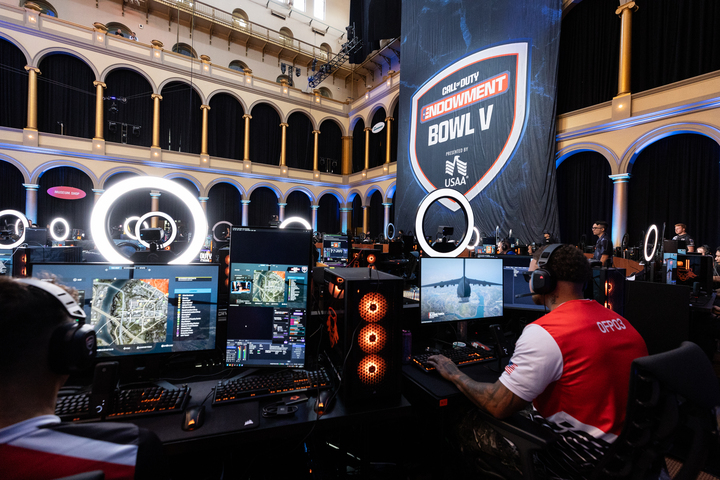
The Army won the biggest esports tournament in the world, a hope for the service’s recruiting efforts as they try to meet more of Gen Z where they’re at: online gaming.
On Wednesday, esports teams from the Army, Navy, Air Force, Marines, Space Force, Coast Guard and the UK and Canada tac-sprinted, corner sliced and sniped their way through the fifth Call of Duty Endowment Bowl V. In an arch-line atrium of a Washington museum, contestants hunched over desks covered in networked desktops and Monster energy drink cans. Teams of two from each service rotated through direct match-ups inside the uber-popular combat game, with each team coached by a professional Call of Duty player.
When the dust settled, the four soldiers on the Army team had scored the most points in head-to-head battles with other services. The team included Staff Sgt. James Sheives, or “Actual,” from Fort Moore, Georgia, and three soldiers from Fort Bliss: Staff Sgt. Randy Ojeda or “ItzDejavvu,” Spc. Chrisopher Montalvo or “Qwae,” and Staff Sgt. Monsef Taj or, “Taj.” It was the Army’s first win in the contest.
Close to 250,000 tuned into the contest’s livestream on YouTube.
“This is, believe it or not, the world’s largest military esports competition,” said Dan Goldenberg, president of the endowment. “It’s international. It’s like the Army-Navy game for everyone.”
The contest was the fifth annual military-wide shootout held by The Call of Duty Endowment, a foundation funded by Activision Blizzard, the game’s maker, to aid veterans transitioning into civilian jobs after service. The endowment donated over $10 million to veteran charities in 2023, according to IRS filings, and since 2009, says its placed 130,000 veterans into jobs with $73 million in nonprofit grants.
In 2020, to the surprise of many, the Space Force pulled out a win – only a couple of years into its existence. For the endowment bowl’s fifth year, the other services were hungry to take home the Monster trophy presented by the Commandant of the Marine Corps.
Their win was not only a first for the Army but potentially a successful marketing campaign. The goal of the Army’s esports teams is to grab the attention of young people who might become recruits, current and former service members said. With the Army’s recruitment overhaul, officials are looking to interact with young people where they are by investing in more online outreach.
“Where is the 17 to 34 audience?” said Christopher Jones, a retired Sergeant First Class, who was playfully referred to as the godfather of Army esports at the event. Jones helped establish the service’s esports team under Army Recruiting Command.
“Gaming is not the reason you enlist,” Jones said. “It’s the second, tertiary, whatever reason. Everybody has their priority reason of why they’re looking at the service but then when they find out, ‘oh, well, I also have a community within my community, like that sounds awesome.’”
The esports team reaches a younger demographic which generally isn’t familiar with Army marketing at all, said Sgt. Brendan Huffman, Army esports media director.
“The value esports provides in marketing is a touch point to the new demographic that [Recruiting Command] has not been the best at reaching out to, or Army marketing as a whole,” he said. “It’s their first time having a good first impression with anything to do with the military.”
Subscribe to Task & Purpose today. Get the latest military news and culture in your inbox daily.
When the Army decided in November 2018 to officially add esports to their roster of Army-sponsored teams, Jones said, “it was kind of a ‘no duh’ moment.” In 2024, esports drew a total of 640 million viewers to its streaming events around the globe, according to Demandsage, a company that collects data for business intelligence.
Montalvo, or “Qwae,” a network communication specialist, made one of the biggest ‘plays’ of the day, taking out two rifle-armed opponents in a solo mission with just a pistol to clinch first place for the team. When he joined the Army, he said, his recruiter specifically discussed the esports team.
“I didn’t really have a plan when I came into the Army,” Montalvo said, adding that esports has given him more soldiers to relate to in a service made up of more than 400,000 people.
The service members at the Bowl typically play in their free time. Some even thought about going pro before they joined the military like Specialist 4 Ryan Cabase, who does cyber security for the Space Force. He said he clocks probably 40 hours a week, the equivalent of another job.
“There’s a lot of young aspiring gamers out there that genuinely get worried about how joining the military could impact being able to fall back on your pastime,” Cabase said. “Seeing service members come out to these types of events and still be able to actively game and be sent out to these cool events and stuff, I think it’s an eye opening kind of thing.”
Huffman said the Army esports program wouldn’t exist without the volunteer players.
“They sacrificed a lot of free time after their normal Army job to compete and play because when they qualify for a tournament, that’s where Fort Knox comes in, and we provide the funding to send them out and compete,” Huffman said.

The soldiers who won the Endowment Bowl are considered “at large” players assigned to different bases across the U.S. but the Army’s official esports team has 16 slots at Fort Knox. Like Army-sponsored athletes seeking to reach the Olympics or other high-profile sports events, the esports team soldiers are assigned to gaming duties full-time.
A normal day, said Huffman, starts with morning PT before they head into the office where they practice playing and review footage of previous sessions and scrimmages they hold against college teams and other opponents. The soldiers might also be “nailing down certain team cohesion issues that they have within the team, or just communications issues.”
The goal, Huffman said, is to qualify for and perform well at national competitions, with wide audiences of possible recruits.
“They maintain their high-level competitiveness to compete at the national level to be on that national broadcasting stage to show that while you’re in the Army, you can still maintain your passions that you had before joining and continue them well after dealing with their service,” Huffman said.
When they’re not training at home, they’re going to tournaments across the country about once a month.
To be one of the 16, soldiers play trials to prove their skills. Soldiers can even move up in rank during their time playing for the Army’s esports team.
“I came in as a specialist. I’m now an E5. We’ve had people jump from E5 all the way to E7 while at Knox,” Huffman said. “It doesn’t stop your military career.”
Some Army players have even been poached for full-ride scholarships to college teams or by professional esports teams, according to Huffman.
Call of Duty Endowment
The Call of Duty competition is a major fundraiser for the endowment, which connects veterans with non-profits specializing in veteran-civilian transitions like Hire Our Heroes. The group’s chief operating officer, Ross Dickman, said that they coached veterans on how to pitch their military experience to civilian employers.
“If you carried a rifle and were in the infantry, for a logistics organization, what use do they have for that? On the surface, it doesn’t translate well. On paper, it’s tough for a hiring manager who’s not military connected to understand that. It’s even harder for the veterans to articulate it, because they’ve been trained against a certain set of objectives,” he said.
They also help veterans practice mock interviews and write resumes.
“They’re very confident in their abilities in the military. They’re confident in who they are. They have a strong degree of self confidence,” Dickman said. “But then, if you get more specific and say, ‘How comfortable do you feel interviewing?’ Pretty low. ‘How confident are you that the resume represents your skills?’ Super low. So we do work on that type of confidence.”
